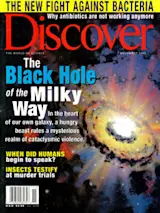What else distinguishes us from the apes besides walking fully upright? We have bigger brains, of course. And we also have bigger butts. Some researchers have wondered whether our rear ends were a prerequisite or a consequence of our upright posture. Now Thomas Greiner, a physical anthropologist at New York Chiropractic College in Seneca Falls, argues that our ample posteriors are a bipedal by-product.
In apes, the gluteus maximus is a relatively puny muscle that attaches to the ischium, the part of the hipbone we sit on. The muscle acts as a hip extensor, pulling the hip backward, and provides good alignment for tree climbing. But the muscle can't keep apes in an upright stance for long--apes quickly tire of standing. Humans, however, have a thick, powerful gluteus maximus that attaches higher up, to the ilium, the broad, flat upper bone of the hip. This higher attachment gives our gluteal ...














